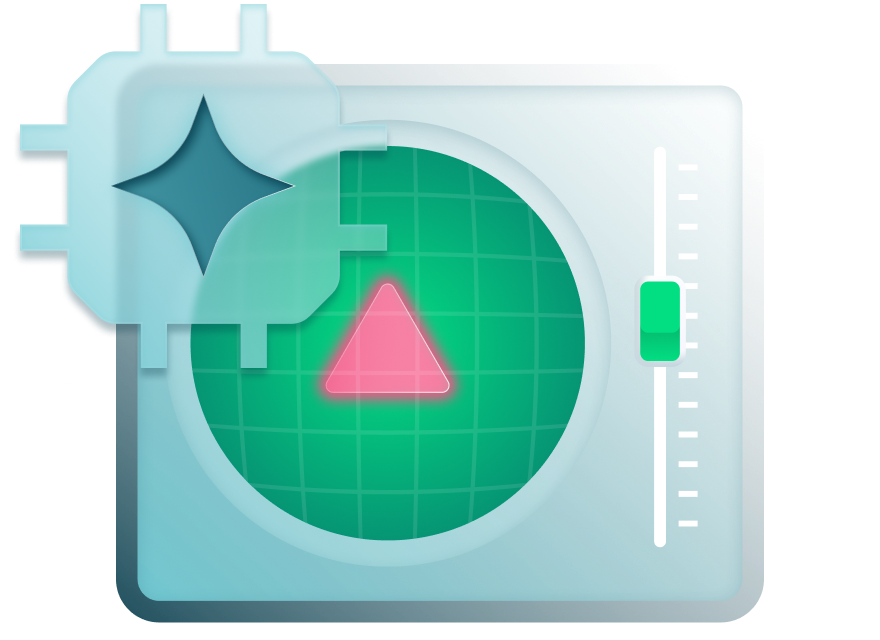TL;DR
AI-SPM is the continuous process of discovering, assessing, monitoring, and improving the security posture of AI systems across data, models, pipelines, and runtime services. It complements cloud, data, application, and SaaS posture programs by covering AI-specific risks such as prompt injection, data poisoning, model extraction, and inference leakage.
What is AI-SPM?
AI Security Posture Management is the security discipline that combines the process of continuous discovering, assessing, monitoring, and strengthening the security posture of AI systems throughout the model lifecycle. It covers risks that traditional security tools often miss, including data poisoning, prompt injection, model extraction, and inference leakage.
AI-SPM brings visibility to AI assets, evaluates configurations and access paths, and monitors model behavior for signs of misuse or drift. It applies to any AI system, whether it is built internally, integrated through a managed third-party service, or embedded inside a SaaS application.
Why AI-SPM matters now
- Rapid adoption of AI in production is expanding the number of models, endpoints, datasets, and SaaS integrations, which increases the attack surface and the potential for shadow AI.
- AI-specific threats require dedicated coverage, including training data poisoning, adversarial prompts, model extraction, and inference leakage. These exposures are not covered fully by most cloud, data, or application posture tools.
- Compliance pressure is rising as organizations document how AI systems are governed and monitored across their lifecycle, which drives demand for traceability and audit evidence.
Core AI-SPM capabilities
How AI-SPM compares to other posture disciplines
| Discipline | What it secures | Where AI-SPM is different |
|---|---|---|
| CSPM | Cloud resources and infrastructure | AI-SPM adds model lifecycle and inference-specific threats that are outside standard cloud config checks |
| DSPM | Data classification, access, and leakage | AI-SPM covers how models use data in training and inference, and monitors model behavior that can leak data |
| ASPM | Custom applications and software posture | AI-SPM addresses model artifacts, pipelines, and prompt or agent risks that are not typical in standard apps |
| SSPM | SaaS configurations, identities, integrations | AI-SPM complements SSPM by covering AI features and model APIs embedded in SaaS apps and workflows |
AI-SPM reference architecture
Best practices for AI-SPM in SaaS-heavy environments
- Build a complete inventory of AI features inside your SaaS apps and connected model APIs
- Classify all AI training and inference data and apply least privilege access with periodic review
- Lock down model endpoints and tokens and rotate credentials on a schedule
- Add runtime monitoring for inference behavior and integrate alerts into your SOC runbooks
- Treat AI supply chain like software supply chain and track dependencies and images across clouds
- Align with your existing SSPM, CSPM, DSPM, and ASPM programs so posture is consistent across stacks
What leading vendors emphasize about AI-SPM
Market leaders consistently call out three themes:
- Lifecycle visibility across models, data, and services
- AI-specific detections for injection, poisoning, extraction, and leakage
- Compliance reporting and evidence generation across clouds and AI providers
Use these themes to evaluate claims and to separate marketing from capabilities.
Getting started checklist
The road ahead
Expect tighter integration of posture management with AI threat protection and runtime inspection across providers, including Microsoft Defender for Cloud, which now documents AI posture and threat protection capabilities across the lifecycle. Expect more coverage for agentic AI and model behavior analytics as attacks evolve.
Want help mapping AI features inside your SaaS stack and closing posture gaps without adding another siloed tool?
Book a personalized demo to see how Valence helps you discover and secure the SaaS and AI integrations you already use (and the ones you may not yet know about).
Frequently Asked Questions
What is AI-SPM?
A continuous program that discovers, assesses, and monitors AI systems across data, models, pipelines, and runtime in order to reduce AI-specific risk and support compliance.
How is AI-SPM different from CSPM and DSPM?
CSPM focuses on cloud configuration and DSPM focuses on data posture. AI-SPM adds model lifecycle and inference behavior so you can catch injection, poisoning, and extraction that cloud or data checks alone will not surface.
Is AI-SPM necessary if we already have CSPM or DSPM?
Yes. CSPM and DSPM provide visibility into cloud resources and data posture. AI-SPM adds controls and monitoring for model behavior, training data integrity, inference risks, and AI-specific attack paths that these tools do not cover.

Does AI-SPM require in-house models?
No. It is relevant for managed AI services and SaaS apps with built-in AI features because misconfigurations and risky usage can still expose data and endpoints.

What should I monitor at runtime?
Unusual query patterns, jailbreak attempts, data leakage indicators, model drift, and unauthorized endpoint access.













